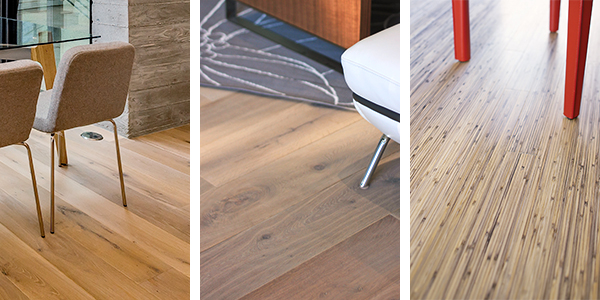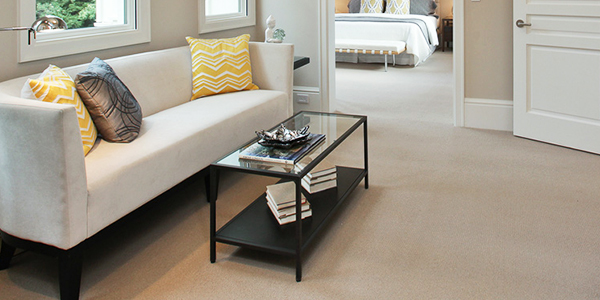These resources are from an archived version of our website. Want to see what we’ve been up to lately? Check out our new website.
Environmentally-friendly flooring: Compare your options

Beautiful flooring can considerably improve the aesthetic of your home – sprawling hardwoods, lush carpets, or smooth concrete can all make a lasting impression in their own way. But besides pleasing the eye, flooring is increasingly becoming a key part of sustainable homebuilding, and can improve the state of your environment.
Studies conducted by the EPA have found that indoor pollutant levels can climb up to five times higher than outdoor pollutant levels. Flooring can be one of the greatest culprits behind these hazards – installations of new carpet or hardwoods can release volatile organic compounds and suspected carcinogens such as formaldehyde and benzene. These studies are concerning, but fortunately, you can proactively fight against toxic materials with a careful consideration of your flooring options.
Explore the new frontier of sustainable flooring
At Clarum, we collaborate with our clients to incorporate sustainable building materials in our high-performing, custom homes. As part of this decision process, clients often ask our advice on which type of sustainable flooring is best fit for their needs. Here, we dive into the characteristics of popular, earth-friendly flooring options:
Oak Floors

In recent history, oak flooring has served as one of the most common materials throughout the world for hardwood floors. Part of its popularity stems from its durability, as it can last more than 100 years. As a testament to its longevity, many homes built at the turn of the 20th century commonly still have their original solid oak flooring intact.
Oak flooring is often considered to have a smaller carbon footprint than other options due to its high availability – thanks to U.S. forestry protection programs, oak trees are constantly being replanted in our forests. Be sure to check that your oak is FSC certified to ensure you’re picking a sustainably-grown product. Additionally, this type of wood flooring tends to release fewer environmental and air pollution emissions toxic emissions, so you can feel better about the space you live in.
Bamboo Floors
 Home builders have increasingly utilized bamboo flooring in recent years due its moderately low cost, durability, and easy installation. Indeed, this renewable grass is naturally anti-bacterial, water resistant and sturdy, making it a clear choice for many homeowners who are invested in an environmentally-friendly yet robust option.
Home builders have increasingly utilized bamboo flooring in recent years due its moderately low cost, durability, and easy installation. Indeed, this renewable grass is naturally anti-bacterial, water resistant and sturdy, making it a clear choice for many homeowners who are invested in an environmentally-friendly yet robust option.
If you’re interested in bamboo flooring, be sure to check the composition of its corresponding glues – it can contain the toxic substance of formaldehyde in lieu of natural-base adhesives. If you have concerns about this element, you may want to consider other options before committing to bamboo.
Concrete Floors
 Concrete poses as one of the most sustainable flooring options on the market – when left exposed, concrete floors can function both as a foundation slab and finished floor. This dual purpose eliminates the need for carpeting or other floor coverings, resulting in a lower carbon footprint and improved indoor air quality. Additionally, concrete utilizes sustainable materials such as limestone, the most abundant mineral on earth.
Concrete poses as one of the most sustainable flooring options on the market – when left exposed, concrete floors can function both as a foundation slab and finished floor. This dual purpose eliminates the need for carpeting or other floor coverings, resulting in a lower carbon footprint and improved indoor air quality. Additionally, concrete utilizes sustainable materials such as limestone, the most abundant mineral on earth.
If you’re uncertain about the aesthetics of concrete floors, fear not. In reality, the material provides great design versatility thanks to techniques such as coloring, staining, stenciling, and polishing. With these options, concrete floors can mimic more traditional materials such as slate – or you can create a gorgeous, entirely unique custom look to align with your taste.
Cork Floors
 Cork flooring presents a viable option for those seeking environmentally-friendly flooring due to its natural, renewable components and relatively long lifespan – cork can last up to 75 years with proper application. Additionally, the material is kind to our earth’s resources. In fact, one cork tree alone can produce supplies for thousands of floors in its lifetime!
Cork flooring presents a viable option for those seeking environmentally-friendly flooring due to its natural, renewable components and relatively long lifespan – cork can last up to 75 years with proper application. Additionally, the material is kind to our earth’s resources. In fact, one cork tree alone can produce supplies for thousands of floors in its lifetime!
Cork flooring has many other elements that make it irresistible to home builders – the substance is naturally resistant to mold and mildew, hypoallergenic, insect-resistant, and poses as an excellent thermal and sound insulator. Above all, many people enjoy how cork feels soft yet firm to the feet, so you can live comfortably and still have a clear conscious.
Wool Carpet

For the environmentally-conscious homeowner, wool can provide a welcome alternative to synthetic materials in carpeting. This all-natural material has significant sustainable benefits – because wool carpeting is often manufactured without any dyes or synthetic materials, it provides a great hypoallergenic option and reduces environmental quality issues. For example, wool carpet doesn’t off-gas – meaning it won’t release harmful, foul-smelling chemicals into its environment – as long as it isn’t installed with any stain-resistant chemicals.
Additionally, wool is easier on the environment (and on your wallet) due to its highly-insulating nature – its ability to limit the transfer of heat or cool air in your home reduces strain on your HVAC system and can lower energy costs.
Build your dream home with zero guilt
When considering flooring options, researching ahead of time will greatly inform your decision process – and you’ll be more satisfied with the results. Long gone are the days in which we’re limited by harmful materials and short-lived options. Broaden your horizons with sustainable flooring possibilities: enhance the beauty of your home while staying kind to the environment.
Want to learn more about how Clarum can help you build the modern home of your dreams? Give us a call at 650.322.7069.
Image of cork flooring courtesy of Green Building Supply








